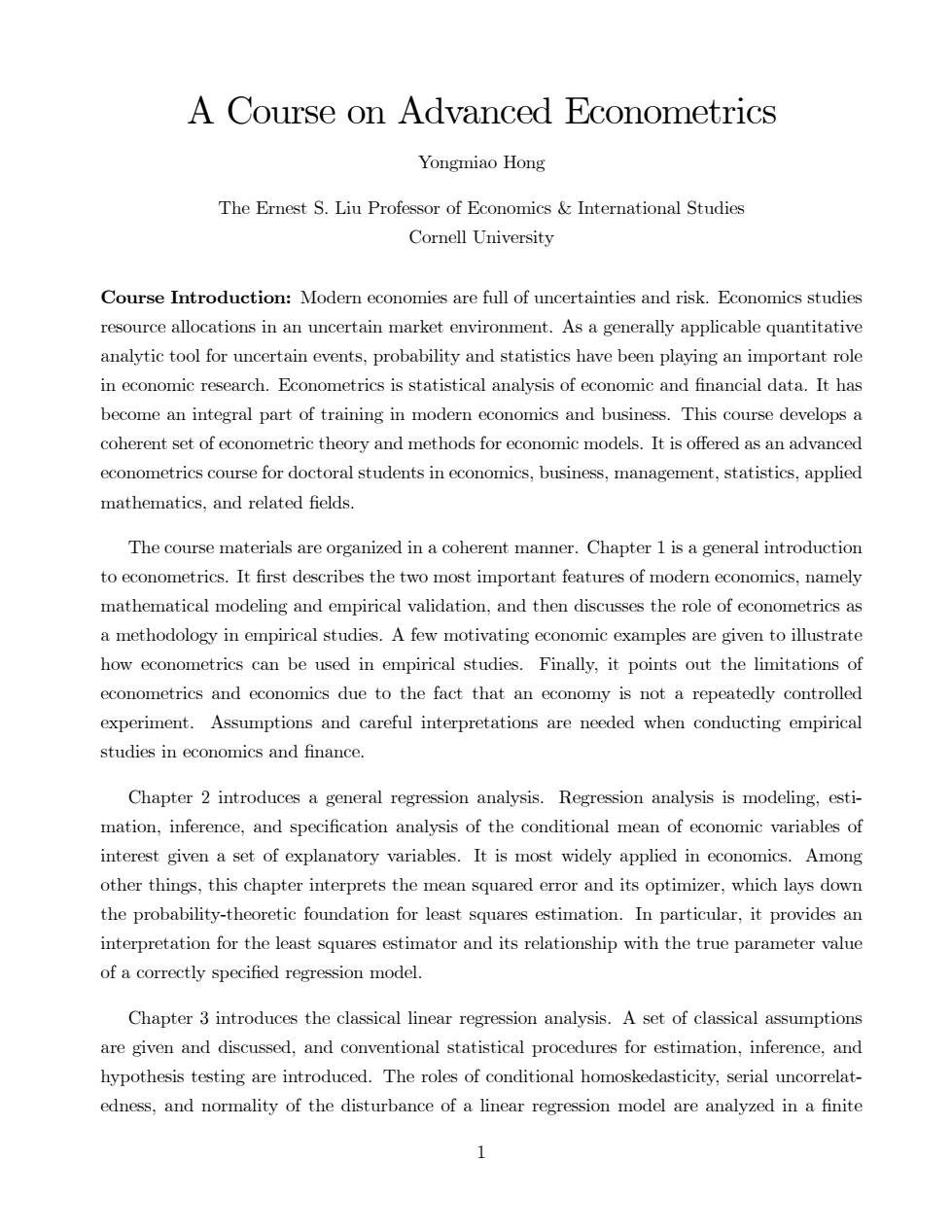正在加载图片...

A Course on Advanced Econometrics Yongmiao Hong The Ernest S.Liu Professor of Economics International Studies Cornell University Course Introduction:Modern economies are full of uncertainties and risk.Economics studies resource allocations in an uncertain market environment.As a generally applicable quantitative analytic tool for uncertain events,probability and statistics have been playing an important role in economic research.Econometrics is statistical analysis of economic and financial data.It has become an integral part of training in modern economics and business.This course develops a coherent set of econometric theory and methods for economic models.It is offered as an advanced econometrics course for doctoral students in economics,business,management,statistics,applied mathematics,and related fields. The course materials are organized in a coherent manner.Chapter 1 is a general introduction to econometrics.It first describes the two most important features of modern economics,namely mathematical modeling and empirical validation,and then discusses the role of econometrics as a methodology in empirical studies.A few motivating economic examples are given to illustrate how econometrics can be used in empirical studies.Finally,it points out the limitations of econometrics and economics due to the fact that an economy is not a repeatedly controlled experiment.Assumptions and careful interpretations are needed when conducting empirical studies in economics and finance. Chapter 2 introduces a general regression analysis.Regression analysis is modeling,esti- mation,inference,and specification analysis of the conditional mean of economic variables of interest given a set of explanatory variables.It is most widely applied in economics.Among other things,this chapter interprets the mean squared error and its optimizer,which lays down the probability-theoretic foundation for least squares estimation.In particular,it provides an interpretation for the least squares estimator and its relationship with the true parameter value of a correctly specified regression model. Chapter 3 introduces the classical linear regression analysis.A set of classical assumptions are given and discussed,and conventional statistical procedures for estimation,inference,and hypothesis testing are introduced.The roles of conditional homoskedasticity,serial uncorrelat- edness,and normality of the disturbance of a linear regression model are analyzed in a finite 1A Course on Advanced Econometrics Yongmiao Hong The Ernest S. Liu Professor of Economics & International Studies Cornell University Course Introduction: Modern economies are full of uncertainties and risk. Economics studies resource allocations in an uncertain market environment. As a generally applicable quantitative analytic tool for uncertain events, probability and statistics have been playing an important role in economic research. Econometrics is statistical analysis of economic and Önancial data. It has become an integral part of training in modern economics and business. This course develops a coherent set of econometric theory and methods for economic models. It is o§ered as an advanced econometrics course for doctoral students in economics, business, management, statistics, applied mathematics, and related Öelds. The course materials are organized in a coherent manner. Chapter 1 is a general introduction to econometrics. It Örst describes the two most important features of modern economics, namely mathematical modeling and empirical validation, and then discusses the role of econometrics as a methodology in empirical studies. A few motivating economic examples are given to illustrate how econometrics can be used in empirical studies. Finally, it points out the limitations of econometrics and economics due to the fact that an economy is not a repeatedly controlled experiment. Assumptions and careful interpretations are needed when conducting empirical studies in economics and Önance. Chapter 2 introduces a general regression analysis. Regression analysis is modeling, estimation, inference, and speciÖcation analysis of the conditional mean of economic variables of interest given a set of explanatory variables. It is most widely applied in economics. Among other things, this chapter interprets the mean squared error and its optimizer, which lays down the probability-theoretic foundation for least squares estimation. In particular, it provides an interpretation for the least squares estimator and its relationship with the true parameter value of a correctly speciÖed regression model. Chapter 3 introduces the classical linear regression analysis. A set of classical assumptions are given and discussed, and conventional statistical procedures for estimation, inference, and hypothesis testing are introduced. The roles of conditional homoskedasticity, serial uncorrelatedness, and normality of the disturbance of a linear regression model are analyzed in a Önite 1